回归
这个概念源于英国生物学家对人类身高的研究。自然界有一种约束力,使人类身高在一定时期是相对稳定的。如果父 母身高矮了(高了),其子女比他们更高(矮),它让身高有一种回归到中心的作用。
linear regression
一个机器学习模型可以划分为三部分。
hypothesis 假设
在这个阶段建立对模型的假设(通常包含未知参数)
learning 学习
构建学习准则(通过优化算法学习得到未知参数)
decision 决策
评判模型的性能
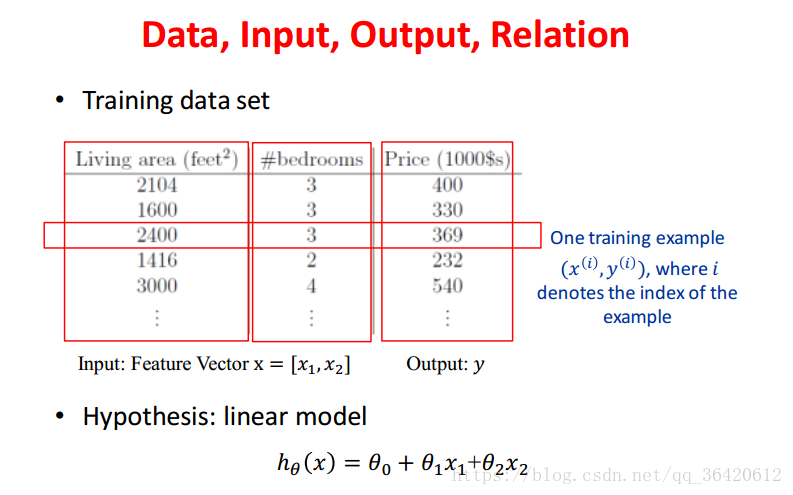
对于图中的房价预测问题,我们建立模型如图。
学习准则是平方误差最小化。
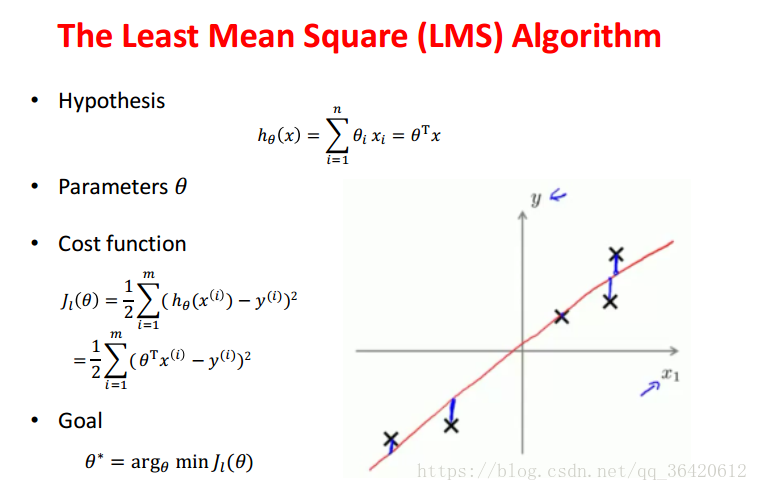
从图中可以看出,平方误差最小化有一个合理的几何解释。它最小化所有样本点到分类面(线)的距离,以期获得最优分类面(线)。
正规方程组法
求解这个问题我们可以直接使用矩阵运算求得结果。

但是,这里涉及到矩阵的逆,难以计算,有时甚至无法计算。
梯度下降法
梯度的定义为:

所以,沿着梯度的方向,函数值增大。沿着负梯度方向,函数值降低。梯度下降法是一个迭代算法,不停沿着负梯度方向前进,直到函数值降低到最优解(或局部最优解)或达到停止条件。
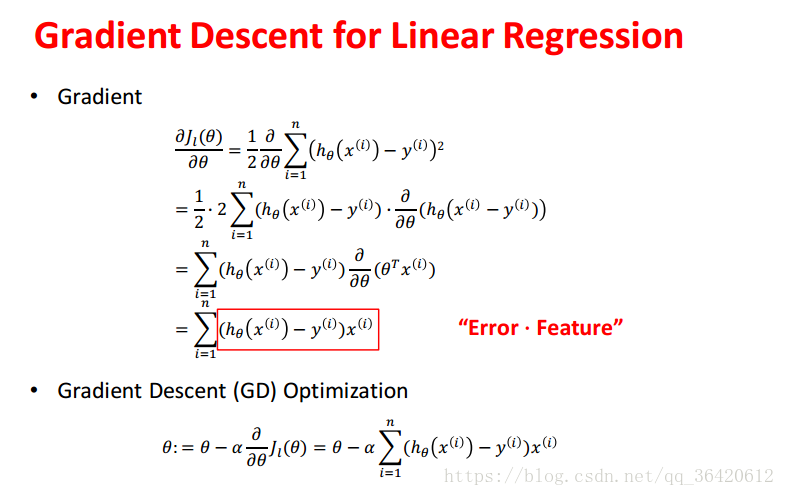
这里有个小练习:
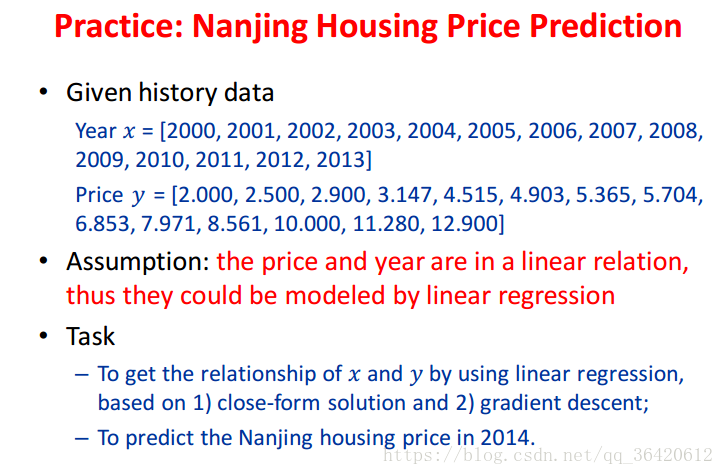
import numpy as np
import matplotlib.pyplot as plt
#特征
x = [ i for i in range(14)]
#标签
y = [2.0,2.5,2.9,3.147,4.515,4.903,5.365,5.704,6.853,7.971,8.561,10.0,11.28,12.9]
def loss(w,b):
#计算损失
error = 0
for i in range(len(x)):
error+=1/2*(w*x[i]+b-y[i])**2
return error
def batch_gradient_descent(maxCycles,alpha,eps):
#批量梯度 batch_gradient_descent
w=0
b=0
iter = 0
error=[]
for i in range(maxCycles):
#计算整个数据集的梯度
sigma1=0
sigma2=0
xx= np.linspace(0,14,15)
ax = fig.add_subplot(2,2,3)
ax.scatter(x,y,s=30,color='black')
for i in range(len(x)):
sigma1 = sigma1 + (w*x[i]+b-y[i])*x[i]
sigma2= sigma2 + (w*x[i]+b - y[i])
w = w - sigma1*alpha/len(x)
b = b - sigma2*alpha/len(x)
yy=w*xx+b
plt.plot(xx,yy,color='red',linestyle=':',linewidth=0.5)#画出拟合直线
plt.xlabel('year')
plt.ylabel('price')
plt.title('batch gradient descent')
iter = iter +1
error.append(loss(w,b))
xx = [i for i in range(len(error))]
ax = fig.add_subplot(2,2,4)
plt.plot(xx,error,c='red')
plt.xlabel('iterations')
plt.ylabel('error')
plt.title('batch error')
if loss(w,b)<eps:
break
print('批量迭代=',iter,'w=',w,'b=',b,'14年房价=',w*14+b)
return w,b
def stochastic_gradient_descent(maxCycles,alpha,eps):
#随机梯度 stochastic_gradient_descent
iter =0
w = 0
b = 0
flag = 0
xx= np.linspace(0,14,15)
ax = fig.add_subplot(2,2,1)
ax.scatter(x,y,s=30,color='black')
error=[]
while True:
for i in range(len(x)):#循环取数据集中的一个样本计算梯度
h = w*x[i]+b
w = w - alpha * (h-y[i]) * x[i]
b = b - alpha * (h - y[i])
yy=w*xx+b
plt.plot(xx,yy,color='blue',linestyle=':',linewidth=0.2)#画出拟合直线
iter = iter+1
error.append(loss(w,b))
if loss(w,b)<eps or iter>=maxCycles:
flag =1
break
if flag:
break
plt.xlabel('year')
plt.ylabel('price')
plt.title('stochastic gradient descent')
ax = fig.add_subplot(2,2,2)#画出损失
xx = [i for i in range(len(error))]
plt.plot(xx,error)
plt.xlabel('iterations')
plt.ylabel('error')
plt.title('stochastic error')
print('随机迭代=',iter,'w=',w,'b=',b,'14年房价=',w*14+b)
return w,b
#初始化参数
maxCycles=200
alpha=0.006
eps = 0.1
#画出数据集
fig = plt.figure()
w1,b1=stochastic_gradient_descent(maxCycles,alpha,eps)
w2,b2=batch_gradient_descent(maxCycles,alpha,eps)
plt.show()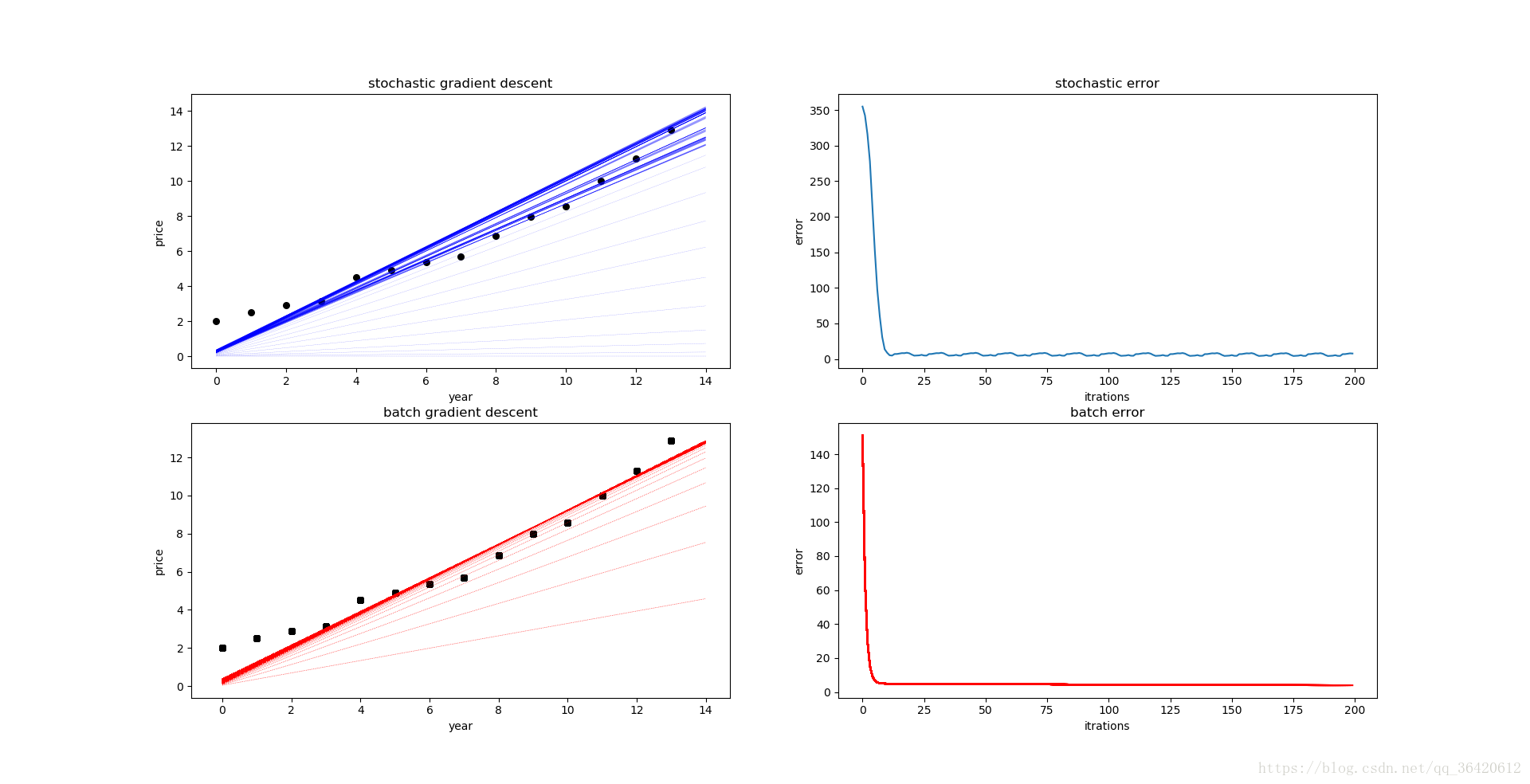




 本文介绍线性回归的基本原理及其在房价预测中的应用,详细解析了假设、学习及决策三个阶段,并对比了批量梯度下降与随机梯度下降两种优化算法。
本文介绍线性回归的基本原理及其在房价预测中的应用,详细解析了假设、学习及决策三个阶段,并对比了批量梯度下降与随机梯度下降两种优化算法。
















 1万+
1万+

 被折叠的 条评论
为什么被折叠?
被折叠的 条评论
为什么被折叠?








